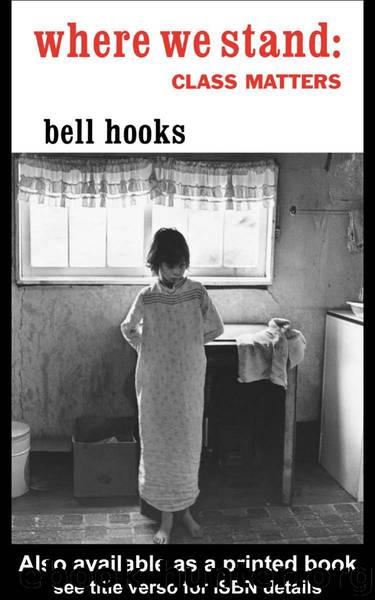Where We Stand: Class Matters by Bell Hooks

Author:Bell Hooks [Hooks, Bell]
Language: eng
Format: epub
ISBN: 9780415929134
Amazon: 041592913X
Publisher: Routledge
Published: 2000-10-06T04:00:00+00:00
8
Class and Race:
The New Black Elite
Collectively, black folks in the United States have never wanted to highlight the issue of class and class exploitation, even though there have always been diverse caste and class groups among African-Americans. Racist biases shaped historical scholarship so that the information about African explorers who came to the Americas before Columbus was suppressed along with elementary knowledge of the black folks who came as explorers and immigrants who were never slaves.
Indeed, until recently most black people telling the story of our presence here in the so-called New World would begin that narrative with slavery. They would not talk about the Africans who came here bringing gifts of cotton seed, or the small numbers of black immigrants who came seeking the same freedom as their white counterparts.
While a few white Americans are willing to acknowledge that a large majority of the European colonizers who came to these shores were indigents and working-class folks seeking to improve their lot, mostly they tell the story of their arrival on these shores by calling attention to the journeys of the privileged. Like their black counterparts, those whites who 90
where we stand
could count themselves among the privileged were few. The vast majority of whites who entered states of indentured servitude were working class and poor. Yet the journeys of the privileged have come to constitute the norm “white” colonizer and/or immigrant experience, whereas the norm for black people continues to be slavery.
Annals of history do let us know that there was caste and class division between the small number of free blacks and the majority of the enslaved black population. More often than not racial solidarity forged a bond between black-skinned folks even if they did not share the same caste or class standing.
They were bonded by the knowledge that at any moment, whether free or enslaved, they could share the same fate.
This did not mean that free blacks did not at times “lord” it over their enslaved counterparts. Nor did enslavement keep some black folks from emulating white colonizers by embracing a color caste hierarchy wherein fair-skinned individuals had higher rank than their white counterparts. This hierarchy based on color would later be reflected in postslavery class divisions.
Since racially mixed slaves often received greater material benefits from their slaveholding white relatives even when those relatives did not publicly acknowledge these blood ties, they often had more resources than their darker counterparts.
Despite segregation and legal racial apartheid, by the onset of the twentieth century distinct class divisions were emerging in segregated black communities. Still, racial solidarity became even more the norm as postslavery white exploitation and oppression intensified. The logic of racial uplift meant that black folks on the bottom of the class hierarchy were encouraged to regard with admiration and respect peers who were gaining class power.
In those days, the tiny privileged black middle class was not seen as the enemy of the working poor and indigent. They were examples that it was possible for everyone to rise. It was this belief that informed W.
Download
This site does not store any files on its server. We only index and link to content provided by other sites. Please contact the content providers to delete copyright contents if any and email us, we'll remove relevant links or contents immediately.
| African-American Studies | Asian American Studies |
| Disabled | Ethnic Studies |
| Hispanic American Studies | LGBT |
| Minority Studies | Native American Studies |
Cecilia; Or, Memoirs of an Heiress — Volume 1 by Fanny Burney(31375)
Cecilia; Or, Memoirs of an Heiress — Volume 3 by Fanny Burney(30969)
Cecilia; Or, Memoirs of an Heiress — Volume 2 by Fanny Burney(30923)
The Great Music City by Andrea Baker(22458)
We're Going to Need More Wine by Gabrielle Union(18111)
Bombshells: Glamour Girls of a Lifetime by Sullivan Steve(13142)
Pimp by Iceberg Slim(12975)
All the Missing Girls by Megan Miranda(12814)
Fifty Shades Freed by E L James(12479)
Talking to Strangers by Malcolm Gladwell(11955)
Norse Mythology by Gaiman Neil(11941)
Crazy Rich Asians by Kevin Kwan(8396)
Mindhunter: Inside the FBI's Elite Serial Crime Unit by John E. Douglas & Mark Olshaker(7874)
The Lost Art of Listening by Michael P. Nichols(6514)
Enlightenment Now: The Case for Reason, Science, Humanism, and Progress by Steven Pinker(6434)
Bad Blood by John Carreyrou(5801)
The Four Agreements by Don Miguel Ruiz(5552)
Weapons of Math Destruction by Cathy O'Neil(5080)
We Need to Talk by Celeste Headlee(4905)
